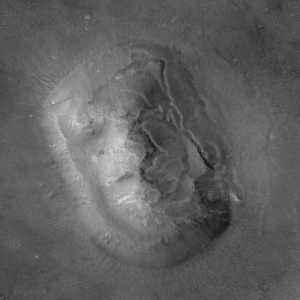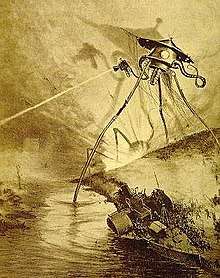Mars in culture
Mars in culture is about the planet Mars in culture. For example, the planet Mars is named after the Roman god of war Mars. In Babylonian astronomy, the planet was named after Nergal, their deity of fire, war, and destruction, most likely due to the planet's reddish appearance.[2] Whether the Greeks equated Nergal with their god of war, Ares, or whether both drew from a more ancient association is unclear.[3] In the age of Plato, the Greeks called the planet Ἄρεως ἀστἡρ (Areos aster), or "star of Ares".[4] Following the identification of Ares and Mars, it was translated into Latin as stella Martis, or "star of Mars", or simply Mars. The Hellenistic Greeks also called the planet Πυρόεις Pyroeis, meaning "fiery".[3]
That fell with a bounce from the stars
To study the mystery of life's early history
P. Smith, University of Arizona,
on Mars Pathfinder, 1997[1]

In the Skanda Purana, a Hindu religious text, Mars is known as the deity Mangala (मंगल) and was born from the sweat of Shiva.[5] The planet is called Angaraka in Sanskrit,[6] after the celibate god of war who possesses the signs of Aries and Scorpio, and teaches the occult sciences. The planet was known by the ancient Egyptians as "Horus of the Horizon",[7] then later Her Deshur[8] ("Ḥr Dšr"), or "Horus the Red".[9] The Hebrews named it Ma'adim (מאדים) — "the one who blushes"; this is where one of the largest canyons on Mars, the Ma'adim Vallis, gets its name.[8] The Chinese, Japanese and Korean cultures refer to the planet as 火星, or the fire star, a name based on the ancient Chinese mythological cycle of Five elements.[10][11][12] In ancient China, the advent of Mars was taken as a portent for "bane, grief, war and murder".[13]
Its symbol, derived from Roman mythology, is a circle with a small arrow pointing out from behind. It is a stylized representation of a shield and spear used by the Roman God Mars.[14] The modern symbol was first found to be written in Byzantine Greek manuscripts dated from the late Middle Ages.[15] Mars in Roman mythology was the God of War and patron of warriors. This symbol is also used in biology to describe the male sex, and in alchemy to symbolise the element iron which was considered to be dominated by Mars whose characteristic red colour is coincidentally due to iron oxide.[16] ♂ occupies Unicode position U+2642.
In The Planets by British composer Gustav Holst, Mars is depicted as the "Bringer of War".[17]
The Flaming Lips won a 2003 Grammy award for their rock instrumental song "Approaching Pavonis Mons by Balloon" from the album Yoshimi Battles the Pink Robots.[18]
In 2015 there was a blockbuster-popularity level movie about a human Mars mission called The Martian (2015), a feature-length film played in over 3800 theaters in the USA.[19] An example of an older film about human Mars mission was the 1964 Robinson Crusoe on Mars, filmed in technicolor film.
In the 1950s Disney produced Man in Space and Mars and Beyond as part of series exploring various space travel concepts with some big names like Werner Von Braun to weigh in and explain spaceflight
The 2001 computer game Red Faction, achieved acclaim in its genre but also achieve a breakout into Mars planning study for its vision of Mars colony.[20]
Intelligent "Martians"

The popular idea that Mars was populated by intelligent Martians exploded in the late 19th century. Schiaparelli's "canali" observations combined with Percival Lowell's books on the subject put forward the standard notion of a planet that was a drying, cooling, dying world with ancient civilizations constructing irrigation works.[21]
Many other observations and proclamations by notable personalities added to what has been termed "Mars Fever".[22] In 1899 while investigating atmospheric radio noise using his receivers in his Colorado Springs lab, inventor Nikola Tesla observed repetitive signals that he later surmised might have been radio communications coming from another planet, possibly Mars. In a 1901 interview Tesla said:
It was some time afterward when the thought flashed upon my mind that the disturbances I had observed might be due to an intelligent control. Although I could not decipher their meaning, it was impossible for me to think of them as having been entirely accidental. The feeling is constantly growing on me that I had been the first to hear the greeting of one planet to another.[23]
Tesla's theories gained support from Lord Kelvin who, while visiting the United States in 1902, was reported to have said that he thought Tesla had picked up Martian signals being sent to the United States.[24] Kelvin "emphatically" denied this report shortly before departing America: "What I really said was that the inhabitants of Mars, if there are any, were doubtless able to see New York, particularly the glare of the electricity."[25]
In a New York Times article in 1901, Edward Charles Pickering, director of the Harvard College Observatory, said that they had received a telegram from Lowell Observatory in Arizona that seemed to confirm that Mars was trying to communicate with the Earth.[26]
Early in December 1900, we received from Lowell Observatory in Arizona a telegram that a shaft of light had been seen to project from Mars (the Lowell observatory makes a specialty of Mars) lasting seventy minutes. I wired these facts to Europe and sent out neostyle copies through this country. The observer there is a careful, reliable man and there is no reason to doubt that the light existed. It was given as from a well-known geographical point on Mars. That was all. Now the story has gone the world over. In Europe it is stated that I have been in communication with Mars, and all sorts of exaggerations have spring up. Whatever the light was, we have no means of knowing. Whether it had intelligence or not, no one can say. It is absolutely inexplicable.[26]
Pickering later proposed creating a set of mirrors in Texas with the intention of signaling Martians.[27]
In recent decades, the high resolution mapping of the surface of Mars, culminating in Mars Global Surveyor, revealed no artifacts of habitation by 'intelligent' life, but pseudoscientific speculation about intelligent life on Mars continues from commentators such as Richard C. Hoagland. Reminiscent of the canali controversy, some speculations are based on small scale features perceived in the spacecraft images, such as 'pyramids' and the 'Face on Mars'. Planetary astronomer Carl Sagan wrote:
Mars has become a kind of mythic arena onto which we have projected our Earthly hopes and fears.[28]

The depiction of Mars in fiction has been stimulated by its dramatic red color and by nineteenth century scientific speculations that its surface conditions not only might support life, but intelligent life.[29] Thus originated a large number of science fiction scenarios, among which is H. G. Wells' The War of the Worlds, published in 1898, in which Martians seek to escape their dying planet by invading Earth. A subsequent US radio adaptation of The War of the Worlds on October 30, 1938 by Orson Welles was presented as a live news broadcast, and became notorious for causing a public panic when many listeners mistook it for the truth.[30]
Influential works included Ray Bradbury's The Martian Chronicles, in which human explorers accidentally destroy a Martian civilization, Edgar Rice Burroughs' Barsoom series, C. S. Lewis' novel Out of the Silent Planet (1938),[31] and a number of Robert A. Heinlein stories before the mid-sixties.[32]
Author Jonathan Swift made reference to the moons of Mars, about 150 years before their actual discovery by Asaph Hall, detailing reasonably accurate descriptions of their orbits, in the 19th chapter of his novel Gulliver's Travels.[33]
A comic figure of an intelligent Martian, Marvin the Martian, appeared on television in 1948 as a character in the Looney Tunes animated cartoons of Warner Brothers, and has continued as part of popular culture to the present.[34]
After the Mariner and Viking spacecraft had returned pictures of Mars as it really is, an apparently lifeless and canal-less world, these ideas about Mars had to be abandoned and a vogue for accurate, realist depictions of human colonies on Mars developed, the best known of which may be Kim Stanley Robinson's Mars trilogy. Pseudo-scientific speculations about the Face on Mars and other enigmatic landmarks spotted by space probes have meant that ancient civilizations continue to be a popular theme in science fiction, especially in film.[35]
The theme of a Martian colony that fights for independence from Earth is a major plot element in the novels of Greg Bear as well as the movie Total Recall (based on a short story by Philip K. Dick) and the television series Babylon 5. Some video games also use this element, including Red Faction and the Zone of the Enders series. Mars (and its moons) were also the setting for the popular Doom video game franchise and the later Martian Gothic.
See also
References
- NASA - Mars Pathfinder Images - November 1997
- Sheehan, William (February 2, 1997). "Motions of Mars". The Planet Mars: A History of Observation and Discovery. Retrieved 2006-06-13.
- Cochrane, Ev (1997). Martian Metamorphoses: The Planet Mars in Ancient Myth & Religion. Aeon Press. pp. 25–35. ISBN 0-9656229-0-8.
- Huffington, A. S.; Gilot, F. (1993). The Gods of Greece. Grove Press. p. 28. ISBN 0-87113-554-X.
- Williams, George Mason (2003). Handbook of Hindu Mythology. Handbooks of World Mythology. ABC-CLIO. p. 209. ISBN 1-57607-106-5.
- Falk, Michael (June 1999). "Astronomical Names for the Days of the Week". Journal of the Royal Astronomical Society of Canada. 93: 122–133. arXiv:astro-ph/0307398. Bibcode:1999JRASC..93..122F. doi:10.1016/j.newast.2003.07.002.
- Gurshtein, Alex A. (1997). "The evolution of the zodiac in the context of ancient oriental history". Vistas in Astronomy. 41 (4): 507–525. Bibcode:1997VA.....41..507G. doi:10.1016/S0083-6656(98)00002-6.
- Greeley, Ronald; Batson, Raymond M. (2007). Planetary Mapping. Cambridge Planetary Science. 6. Cambridge University Press. pp. 97, 107. ISBN 0-521-03373-X.
- Krupp, Edwin C. (2003). Echoes of the Ancient Skies: The Astronomy of Lost Civilizations. Astronomy Series. Courier Dover Publications. p. 70. ISBN 0-486-42882-6.
- De Groot, Jan Jakob Maria (1912). Religion in China: universism. a key to the study of Taoism and Confucianism. American lectures on the history of religions. 10. G. P. Putnam's Sons. p. 300. Retrieved 2010-01-08.
- Crump, Thomas (1992). The Japanese numbers game: the use and understanding of numbers in modern Japan. Nissan Institute/Routledge Japanese studies series. Routledge. pp. 39–40. ISBN 0415056098.
- Hulbert, Homer Bezaleel (1909). The passing of Korea. Doubleday, Page & company. p. 426. Retrieved 2010-01-08.
- Cochrane, Ev (1997). Martian Metamorphoses: The Planet Mars in Ancient Myth & Religion. Aeon Press. p. 74. ISBN 0-9656229-0-8.
- Maunder, A. S. D. (August 1934). "The origin of the symbols of the planets". The Observatory. 57: 238–247. Bibcode:1934Obs....57..238M.
- Evans, James (1998). The History & Practice of Ancient Astronomy. Oxford University Press US. p. 350. ISBN 0-19-509539-1.
- "Planet Symbols". NASA solar system exploration. Retrieved 2006-06-13.
- Holmes, Paul (1997). Holst: his life and times. The illustrated lives of the great composers. Omnibus Press. pp. 57–60. ISBN 0-7119-6525-0.
- "Newcomer Jones stuns Grammys". BBC News. February 24, 2003. Retrieved 2009-12-28.
- "Percivel Lowell's Canals". Archived from the original on 2007-02-19. Retrieved 2007-03-01.
- Fergus, Charles (2004). "Mars Fever". Research/Penn State. 24 (2). Retrieved 2007-08-02.
- Tesla, Nikola (February 19, 1901). "Talking with the Planets". Collier's Weekly. pp. 4–5. Retrieved 2018-03-03. Cite magazine requires
|magazine=(help) - Cheney, Margaret (1981). Tesla, man out of time. Englewood Cliffs, New Jersey: Prentice-Hall. p. 162. ISBN 978-0-13-906859-1. OCLC 7672251.
- "Departure of Lord Kelvin". The New York Times. May 11, 1902. p. 29.
- Pickering, Edward Charles (January 16, 1901). "The Light Flash From Mars". The New York Times. Archived from the original (PDF) on 2018-06-12. Retrieved 2007-05-20. Alt URL
- Fradin, Dennis Brindell (1999). Is There Life on Mars?. McElderry Books. p. 62. ISBN 0-689-82048-8.
- Sagan, Carl (1980). Cosmos. New York, USA: Random House. p. 106. ISBN 0-394-50294-9.
- Lightman, Bernard V. (1997). Victorian Science in Context. University of Chicago Press. pp. 268–273. ISBN 0-226-48111-5.
- Lubertozzi, Alex; Holmsten, Brian (2003). The war of the worlds: Mars' invasion of earth, inciting panic and inspiring terror from H.G. Wells to Orson Welles and beyond. Sourcebooks, Inc. pp. 3–31. ISBN 1-57071-985-3.
- Schwartz, Sanford (2009). C. S. Lewis on the Final Frontier: Science and the Supernatural in the Space Trilogy. Oxford University Press US. pp. 19–20. ISBN 0-19-537472-X.
- Buker, Derek M. (2002). The science fiction and fantasy readers' advisory: the librarian's guide to cyborgs, aliens, and sorcerers. ALA readers' advisory series. ALA Editions. p. 26. ISBN 0-8389-0831-4.
- Darling, David. "Swift, Jonathan and the moons of Mars". Retrieved 2007-03-01.
- Rabkin, Eric S. (2005). Mars: a tour of the human imagination. Greenwood Publishing Group. pp. 141–142. ISBN 0-275-98719-1.
- Miles, Kathy; Peters II, Charles F. "Unmasking the Face". StarrySkies.com. Retrieved 2007-03-01.